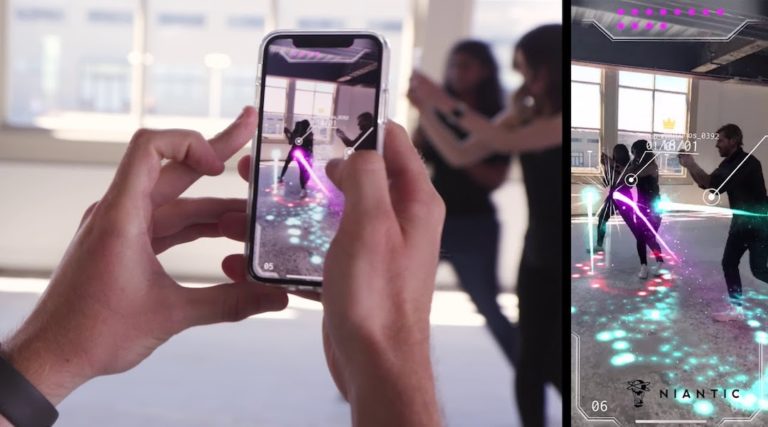
The AR sector has gotten slammed (excuse the pun) for not producing a mass-market killer app. Pokemon Go and Snapchat Lenses have certainly reached killer app-like penetration. But world-immersive AR isn’t there yet.
The question is whether or not that’s a bad thing. Does AR need a killer app yet? Looking to historical evidence — our favorite pastime — iPhone killer apps didn’t arrive until 2-3 years after the device’s introduction. 2-3 years from ARkit’s June 2017 launch is later this year or next year.
Like with the iPhone, this is the requisite incubation period for developers to gain their native footing. We’re otherwise anchored to the mentality of legacy technology. At the time of the iPhone’s 2007 launch, that meant a desktop mentality. Today, it means a mobile 2D mentality.
“You couldn’t make an Uber-style app when it was on a PC,” said Niantic’s (then Escher Reality) Ross Finman at TC Disrupt in late ’17. “It only made sense after a mobile platform came out. Now it’s about understanding what are the new things you can do with the mobile platform for AR.”

Today’s Flashlight Apps
The iPhone’s 2-3 year mental acclimation — 2007 to circa-2010 — was when developers started to wrap their brains around a fundamentally new form factor and set of user interactions. There were new components like GPS and accelerometers, around which apps could be built.
“In 2007 when Apple launched the iPhone, most of the apps were flashlights,” added Niantic’s Diana Hu on the same Disrupt panel. “People didn’t know what to do yet. And there’s going to be this phase of learning. There’s a genesis of any technology when people need to experiment.”
The eventual result for the iPhone was killer apps we started to see around 2010, including Waze, Uber and Foursquare. Think of how those apps were a departure from the pre-iPhone mindset of 2007. No one was thinking of Uber in 2007, except perhaps Travis Kalanick and Garrett Camp.
“It’s wonderful to go and watch the [iPhone] launch video,” said Google’s Ryan Hickman. “The features were so boring… you get a browser, you get iTunes… If Steve Jobs had said ‘you’ll pull out your phone to call a random stranger to pick you up in their car’ [we’d think], ‘are you crazy?’”
What and When
So the question is, when will AR’s killer apps arrive? It won’t exactly follow the 2-3 year incubation cycle we saw with those early iPhone apps, but it could be close. As for the what, the requisite mindset shift means, by definition, that we don’t yet know what those apps will be.
That’s not a cop-out hopefully. In fact, though we don’t know the exact nature of AR’s eventual killer apps, there are some attributes we believe they’ll carry. For example, they’ll have some novelty but will rely more on factors like all-day utility and capacity for frequent use.
Pointing to a few examples in today’s landscape, AR experiences that have these traits include “try before you buy,” product visualization. They solve real pain points and align true utility with monetizable and commerce-oriented experiences. The latter is where brands will actually invest.
An even better example can be seen in Google’s interlinked AR efforts. That includes visual search, which has the greatest potential “all-day” use case in terms of utility and frequency. And VPS will solve real user pain points — on city streets and retail environments (again, monetizable).

Front-end Alignment
This alignment of user appeal and business case that we keep mentioning is critical. Of course, the primary factor for killer-apps is quality and UX. But if that’s aligned with business interests, as with Visual Search and VPS, it will get investment from tech giants that are leading the way.
But even with that investment, time still is required to get there. The tech giants paving the roads for AR can only do so much in building the platforms. The developer community still has to build apps. And that requires the time, acclimation and the steady mindset-shift argued above.
It might not be be the same three-year germination period that we saw with the iPhone. But that’s at least the timeframe in which AR should be forgiven for not yet producing mass-market killer apps. And there’s a chance it won’t even be an app. Either way, AR needs more time in the oven.
“From when I was a kid, where we only had three [television] channels, to today where we’re awash in information… it was 50 years,” Charlie Fink said from the stage at AWE Europe Munich in October. “So let’s have some perspective here because this is a long path.”
For deeper XR data and intelligence, join ARtillry PRO and subscribe to the free ARtillry Weekly newsletter.
Disclosure: ARtillry has no financial stake in the companies mentioned in this post, nor received payment for its production. Disclosure and ethics policy can be seen here.
Header image credit: Niantic
